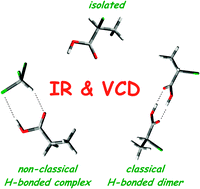Effects of strong and weak hydrogen bond formation on VCDspectra: a case study of 2-chloropropionic acid†‡
Abstract
The

- This article is part of the themed collection: Weak hydrogen bonds – strong effects?
* Corresponding authors
a
Laboratory of Molecular Spectroscopy, Institute of Chemistry, Eötvös University, PO Box 32, Budapest 112, Hungary
E-mail:
tarczay@chem.elte.hu
b Laboratory for Chiroptical Structure Analysis, Institute of Chemistry, Eötvös University, PO Box 32, Budapest 112, Hungary
The

 Please wait while we load your content...
Something went wrong. Try again?
Please wait while we load your content...
Something went wrong. Try again?
S. Góbi, E. Vass, G. Magyarfalvi and G. Tarczay, Phys. Chem. Chem. Phys., 2011, 13, 13972 DOI: 10.1039/C1CP20797K
To request permission to reproduce material from this article, please go to the Copyright Clearance Center request page.
If you are an author contributing to an RSC publication, you do not need to request permission provided correct acknowledgement is given.
If you are the author of this article, you do not need to request permission to reproduce figures and diagrams provided correct acknowledgement is given. If you want to reproduce the whole article in a third-party publication (excluding your thesis/dissertation for which permission is not required) please go to the Copyright Clearance Center request page.
Read more about how to correctly acknowledge RSC content.
 Fetching data from CrossRef.
Fetching data from CrossRef.
This may take some time to load.
Loading related content
